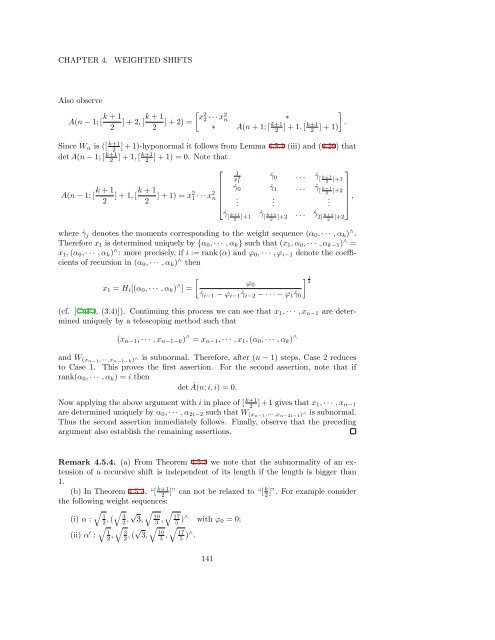Woo Young Lee Lecture Notes on Operator Theory
Woo Young Lee Lecture Notes on Operator Theory
Woo Young Lee Lecture Notes on Operator Theory
You also want an ePaper? Increase the reach of your titles
YUMPU automatically turns print PDFs into web optimized ePapers that Google loves.
CHAPTER 4.<br />
WEIGHTED SHIFTS<br />
Also observe<br />
A(n − 1; [ k + 1<br />
2<br />
Since W α is ([ k+1<br />
2<br />
det A(n − 1; [ k+1<br />
2<br />
A(n − 1; [ k + 1<br />
2<br />
] + 2, [ k + 1 [ x<br />
2<br />
] + 2) = 2 · · · x 2 n ∗<br />
2<br />
]<br />
∗ A(n + 1; [ k+1 k+1<br />
2<br />
] + 1, [<br />
2 ] + 1) .<br />
] + 1)-hyp<strong>on</strong>ormal it follows from Lemma 4.5.1 (iii) and (4.29) that<br />
k+1<br />
] + 1, [<br />
2<br />
] + 1) = 0. Note that<br />
] + 1, [ k + 1<br />
2<br />
⎡<br />
] + 1) = x 2 1 · · · x 2 n ⎢<br />
⎣<br />
1<br />
x 2 1<br />
ˆγ 0 . . . ˆγ [<br />
k+1<br />
ˆγ 0 ˆγ 1 . . . ˆγ [<br />
k+1<br />
.<br />
.<br />
ˆγ [<br />
k+1<br />
2 ]+1 ˆγ [<br />
k+1<br />
2 ]+2 . . . ˆγ 2[<br />
k+1<br />
⎤<br />
2 ]+1<br />
2 ]+2<br />
⎥<br />
.<br />
2 ]+2<br />
where ˆγ j denotes the moments corresp<strong>on</strong>ding to the weight sequence (α 0 , · · · , α k ) ∧ .<br />
Therefore x 1 is determined uniquely by {α 0 , · · · , α k } such that (x 1 , α 0 , · · · , α k−1 ) ∧ =<br />
x 1 , (α 0 , · · · , α k ) ∧ : more precisely, if i := rank (α) and φ 0 , · · · , φ i−1 denote the coefficients<br />
of recursi<strong>on</strong> in (α 0 , · · · , α k ) ∧ then<br />
[<br />
] 1<br />
x 1 = H i [(α 0 , · · · , α k ) ∧ 2<br />
φ 0<br />
] =<br />
ˆγ i−1 − φ i−1ˆγ i−2 − · · · − φ 1ˆγ 0<br />
(cf. [CuF3, (3.4)]). C<strong>on</strong>tinuing this process we can see that x 1 , · · · , x n−1 are determined<br />
uniquely by a telescoping method such that<br />
(x n−1 , · · · , x n−1−k ) ∧ = x n−1 , · · · , x 1 , (α 0 , · · · , α k ) ∧<br />
and W (xn−1 ,··· ,x n−1−k ) ∧ is subnormal. Therefore, after (n − 1) steps, Case 2 reduces<br />
to Case 1. This proves the first asserti<strong>on</strong>. For the sec<strong>on</strong>d asserti<strong>on</strong>, note that if<br />
rank(α 0 , · · · , α k ) = i then<br />
det Â(n; i, i) = 0.<br />
Now applying the above argument with i in place of [ k+1<br />
2 ] + 1 gives that x 1, · · · , x n−1<br />
are determined uniquely by α 0 , · · · , α 2i−2 such that W (xn−1 ,··· ,x n−2i−1 ) ∧ is subnormal.<br />
Thus the sec<strong>on</strong>d asserti<strong>on</strong> immediately follows. Finally, observe that the preceding<br />
argument also establish the remaining asserti<strong>on</strong>s.<br />
⎦ ,<br />
Remark 4.5.4. (a) From Theorem 4.5.3 we note that the subnormality of an extensi<strong>on</strong><br />
of a recursive shift is independent of its length if the length is bigger than<br />
1.<br />
(b) In Theorem 4.5.3, “[ k+1<br />
2 ]” can not be relaxed to “[ k 2<br />
]”. For example c<strong>on</strong>sider<br />
the following weight sequences:<br />
√ √<br />
1<br />
(i) α :<br />
2 , ( 3<br />
2 , √ √ √<br />
10<br />
3,<br />
3<br />
√ √<br />
,<br />
(ii) α ′ 1<br />
:<br />
2 , 3<br />
2 , (√ 3,<br />
√ √<br />
10<br />
3 , 17<br />
5 )∧ .<br />
17<br />
5 )∧ with φ 0 = 0;<br />
141













